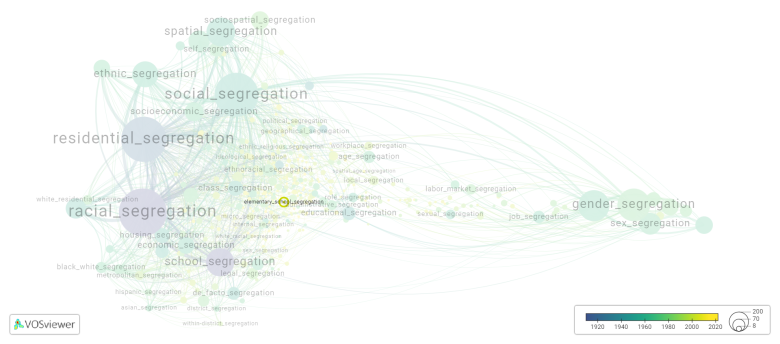Elementary school segregation: Difference between revisions
(Creating page) |
(Creating page) |
||
| (7 intermediate revisions by the same user not shown) | |||
| Line 1: | Line 1: | ||
===== Date and country of first publication<ref>Date and country of first publication as informed by the Scopus database (December 2023).</ref>===== | |||
2014<br> | 2014<br> | ||
United States | United States | ||
===== Definition ===== | |||
Elementary school segregation refers to the practice of separating students based on their race, ethnicity, or other characteristics in educational settings. This practice was common in the United States prior to the Civil Rights Movement, when African American students were often forced to attend separate schools from their white counterparts. This segregation was ultimately ruled unconstitutional by the Supreme Court in the landmark case Brown v. Board of Education in 1954. Today, segregation in elementary schools can still occur in some areas due to factors such as housing patterns and school district boundaries, leading to unequal access to resources and opportunities for students of different backgrounds. Efforts to address and combat school segregation continue to be important in promoting equity and inclusivity in education. | Elementary school segregation refers to the practice of separating students based on their race, ethnicity, or other characteristics in educational settings. This practice was common in the United States prior to the Civil Rights Movement, when African American students were often forced to attend separate schools from their white counterparts. This segregation was ultimately ruled unconstitutional by the Supreme Court in the landmark case Brown v. Board of Education in 1954. Today, segregation in elementary schools can still occur in some areas due to factors such as housing patterns and school district boundaries, leading to unequal access to resources and opportunities for students of different backgrounds. Efforts to address and combat school segregation continue to be important in promoting equity and inclusivity in education. | ||
==See also== | ==See also== | ||
==Related segregation forms== | |||
Elementary school segregation is frequently discussed in the literature with the following segregation forms: | |||
[[school segregation]], [[residential segregation]] | |||
[[File:elementary_school_segregation.png|780x780px]] | |||
This visualization is based on the study [[Segregation_Wiki:About| The Multidisciplinary Landscape of Segregation Research]]. | |||
For the complete network of interrelated segregation forms, please refer to: | |||
* [https://tinyurl.com/2235lkhw First year of publication] | |||
* [https://tinyurl.com/2d8wg5n3 Louvain clusters] | |||
* [https://tinyurl.com/223udk5r Betweenness centrality] | |||
* [https://tinyurl.com/244d8unz Disciplines in which segregation forms first emerged (Scopus database).] | |||
==References== | ==References== | ||
==Notes== | ==Notes== | ||
<references /> | <references /> | ||
{{NoteAI}} | {{NoteAI}} | ||
== | ==Elementary school segregation appears in the following literature== | ||
Siegel-Hawley G. (2014) | Siegel-Hawley G. (2014). Race, choice and richmond public schools: New possibilities and ongoing challenges for diversity in urban districts. ''Urban Review'', ''46''(4), 507-534. Kluwer Academic Publishers.https://doi.org/10.1007/s11256-014-0277-6 | ||
Latest revision as of 07:17, 16 October 2024
Date and country of first publication[1][edit | edit source]
2014
United States
Definition[edit | edit source]
Elementary school segregation refers to the practice of separating students based on their race, ethnicity, or other characteristics in educational settings. This practice was common in the United States prior to the Civil Rights Movement, when African American students were often forced to attend separate schools from their white counterparts. This segregation was ultimately ruled unconstitutional by the Supreme Court in the landmark case Brown v. Board of Education in 1954. Today, segregation in elementary schools can still occur in some areas due to factors such as housing patterns and school district boundaries, leading to unequal access to resources and opportunities for students of different backgrounds. Efforts to address and combat school segregation continue to be important in promoting equity and inclusivity in education.
See also[edit | edit source]
Related segregation forms[edit | edit source]
Elementary school segregation is frequently discussed in the literature with the following segregation forms:
school segregation, residential segregation

This visualization is based on the study The Multidisciplinary Landscape of Segregation Research.
For the complete network of interrelated segregation forms, please refer to:
References[edit | edit source]
Notes[edit | edit source]
- ↑ Date and country of first publication as informed by the Scopus database (December 2023).
At its current state, this definition has been generated by a Large Language Model (LLM) so far without review by an independent researcher or a member of the curating team of segregation experts that keep the Segregation Wiki online. While we strive for accuracy, we cannot guarantee its reliability, completeness and timeliness. Please use this content with caution and verify information as needed. Also, feel free to improve on the definition as you see fit, including the use of references and other informational resources. We value your input in enhancing the quality and accuracy of the definitions of segregation forms collectively offered in the Segregation Wiki ©.
Elementary school segregation appears in the following literature[edit | edit source]
Siegel-Hawley G. (2014). Race, choice and richmond public schools: New possibilities and ongoing challenges for diversity in urban districts. Urban Review, 46(4), 507-534. Kluwer Academic Publishers.https://doi.org/10.1007/s11256-014-0277-6
